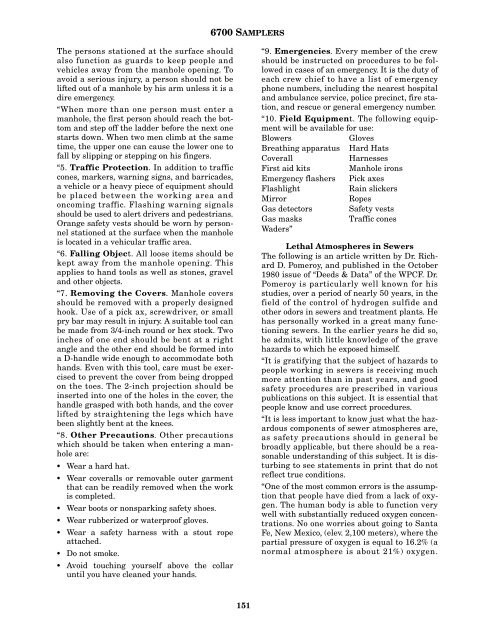6700 Portable Sampler User Manual - Isco
6700 Portable Sampler User Manual - Isco
6700 Portable Sampler User Manual - Isco
You also want an ePaper? Increase the reach of your titles
YUMPU automatically turns print PDFs into web optimized ePapers that Google loves.
The persons stationed at the surface should<br />
also function as guards to keep people and<br />
vehicles away from the manhole opening. To<br />
avoid a serious injury, a person should not be<br />
lifted out of a manhole by his arm unless it is a<br />
dire emergency.<br />
“When more than one person must enter a<br />
manhole, the first person should reach the bottom<br />
and step off the ladder before the next one<br />
starts down. When two men climb at the same<br />
time, the upper one can cause the lower one to<br />
fall by slipping or stepping on his fingers.<br />
“5. Traffic Protection. In addition to traffic<br />
cones, markers, warning signs, and barricades,<br />
a vehicle or a heavy piece of equipment should<br />
be placed between the working area and<br />
oncoming traffic. Flashing warning signals<br />
should be used to alert drivers and pedestrians.<br />
Orange safety vests should be worn by personnel<br />
stationed at the surface when the manhole<br />
is located in a vehicular traffic area.<br />
“6. Falling Object. All loose items should be<br />
kept away from the manhole opening. This<br />
applies to hand tools as well as stones, gravel<br />
and other objects.<br />
“7. Removing the Covers. Manhole covers<br />
should be removed with a properly designed<br />
hook. Use of a pick ax, screwdriver, or small<br />
pry bar may result in injury. A suitable tool can<br />
be made from 3/4-inch round or hex stock. Two<br />
inches of one end should be bent at a right<br />
angleandtheotherendshouldbeformedinto<br />
aD-handlewideenoughtoaccommodateboth<br />
hands. Even with this tool, care must be exercised<br />
to prevent the cover from being dropped<br />
on the toes. The 2-inch projection should be<br />
inserted into one of the holes in the cover, the<br />
handle grasped with both hands, and the cover<br />
lifted by straightening the legs which have<br />
been slightly bent at the knees.<br />
“8. Other Precautions. Other precautions<br />
which should be taken when entering a manhole<br />
are:<br />
Wear a hard hat.<br />
Wear coveralls or removable outer garment<br />
that can be readily removed when the work<br />
is completed.<br />
Wear boots or nonsparking safety shoes.<br />
Wear rubberized or waterproof gloves.<br />
Wear a safety harness with a stout rope<br />
attached.<br />
Do not smoke.<br />
Avoid touching yourself above the collar<br />
until you have cleaned your hands.<br />
<strong>6700</strong> SAMPLERS<br />
151<br />
“9. Emergencies. Every member of the crew<br />
should be instructed on procedures to be followed<br />
in cases of an emergency. It is the duty of<br />
each crew chief to have a list of emergency<br />
phone numbers, including the nearest hospital<br />
and ambulance service, police precinct, fire station,<br />
and rescue or general emergency number.<br />
“10. Field Equipment. The following equipment<br />
will be available for use:<br />
Blowers Gloves<br />
Breathing apparatus Hard Hats<br />
Coverall Harnesses<br />
First aid kits Manhole irons<br />
Emergency flashers Pick axes<br />
Flashlight Rain slickers<br />
Mirror Ropes<br />
Gas detectors Safety vests<br />
Gas masks Traffic cones<br />
Waders”<br />
Lethal Atmospheres in Sewers<br />
The following is an article written by Dr. Richard<br />
D. Pomeroy, and published in the October<br />
1980 issue of “Deeds & Data” of the WPCF. Dr.<br />
Pomeroy is particularly well known for his<br />
studies, over a period of nearly 50 years, in the<br />
field of the control of hydrogen sulfide and<br />
other odors in sewers and treatment plants. He<br />
has personally worked in a great many functioning<br />
sewers. In the earlier years he did so,<br />
he admits, with little knowledge of the grave<br />
hazards to which he exposed himself.<br />
“It is gratifying that the subject of hazards to<br />
people working in sewers is receiving much<br />
more attention than in past years, and good<br />
safety procedures are prescribed in various<br />
publications on this subject. It is essential that<br />
people know and use correct procedures.<br />
“It is less important to know just what the hazardous<br />
components of sewer atmospheres are,<br />
as safety precautions should in general be<br />
broadly applicable, but there should be a reasonable<br />
understanding of this subject. It is disturbing<br />
to see statements in print that do not<br />
reflect true conditions.<br />
“One of the most common errors is the assumption<br />
that people have died from a lack of oxygen.<br />
The human body is able to function very<br />
well with substantially reduced oxygen concentrations.<br />
No one worries about going to Santa<br />
Fe, New Mexico, (elev. 2,100 meters), where the<br />
partial pressure of oxygen is equal to 16.2% (a<br />
normal atmosphere is about 21%) oxygen.

















